The Untold Story of a TPLF Hostage Crisis
Blog
Eliezer
I'm an Engineer based in California & born in Addis Abeba. I am a Senior Engineer at LinkedIn. I studied Computer Science at Stanford and previously worked on Ads engineering at Facebook. I've also run my own startup & and worked in a few others in Seattle & San Francisco. Most of this site is currently dedicated to understanding geopolitical issues involving Ethiopia.
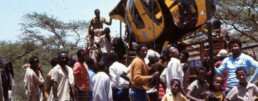
The following story is article version of a tweet shared on Aug 20 2021 based on accounts from US Embassy and State Department cables from the Jimmy Carter Administration declassified by the US National Archives and Records Administration in April 2014. All the cables can be accessed in chronological order here.
On October 31st, 1978 TPLF militants abducted an American helicopter pilot and triggered an international hostage crisis. What follows is the untold story of how the TPLF introduced itself to the United States [1] .
Northern Ethiopia faced a severe locust invasion in 1978. According to a June 1978 Washington Post article, “43 swarms [of locusts] have been spotted in Ethiopia” and locusts were devouring “8,000 to 34,000 tons [of vegetation] each day”. The UN’s Desert Locust Control Organization of Eastern Africa was at the forefront addressing the crisis and had a fleet of 9 aircraft shared between seven countries. One of these aircraft had been stranded near the Kola Tembien region for three months and required several repairs.
At the time, George William Krois, was a 36 year old American helicopter pilot and Canadian resident flying frequent locust control missions in Tigray. George worked for Viking Helicopter Ltd., a Canadian contractor performing services for the UN. On October 30th, Krois had flown two missions ferrying mechanics to repair a UN spray aircraft that had been grounded in Abiy Adi.

According to an account given by Canadian Pilot Bill Waugh, a co-worker of Krois’ at Viking Helicopter, wages for locals guarding the aircraft had been delayed for several days. Soon, locals guarding the grounded aircraft had began to grumble. Word soon started to spread of a third flight that would deliver their payments. TPLF bandits in the countryside heard these rumors and quickly moved to the area.
On the arrival of the third mission, TPLF gunmen charged the helicopter, held Krois under gunpoint and ordered him to reroute and fly to a TPLF-held location. The gunmen stole all the cash and also kidnapped four Ethiopian mechanics who arrived with Krois and instructed them to walk 70 kms on foot in the same direction. Krois and the TPLF bandits landed at a remote site and curious local peasants flocked toward the helicopter. TPLF told the peasants that the helicopter “was a gift from the Arabs and that there would be more” to come and loaded it on a truck and drove away.

Tigrayan Elders Enraged at TPLF
In Abiy Adi, Tigrayans were enraged by the abduction, fearing the UN would suspend the highly effective Locust Control Program in their community. The head of the UN’s Locust Control Program in Addis, a man by the name of Mulugetta Bizuneh heard the news of the abduction and immediately dispatched locals from Abiy Adi to search for the TPLF bandits in different directions, on foot, to try to contact the guerillas and secure the release of his staff.
After a few days of searching, on the 5th of November, large crowds of residents and church leaders finally found the TPLF bandits in the countryside. The crowd, who had travelled a long distance, demanded the TPLF release George Krois and the four Ethiopians.
The TPLF rebuffed their demands and told the crowd that the captives were “agents of the Ethiopian government“. The crowds forcefully protested and argued that the captives were civil servants helping their community battle locust swarms.
When the uproar from the crowd wouldn’t relent, the TPLF agreed to hold a detailed deliberation under the condition that church leaders leave. The crowds strongly objected. Then TPLF leaders began a one hour lecture explaining their discomfort with crosses and church leaders.

At last, the sides agreed to have a meeting in which church leaders were cast to one side and villagers to another. The TPLF, then proceeded to deliver another two hour lecture, this time about the goal of its movement as described in its manifesto. The crowd, then became very agitated.
The meeting adjourned without a discussion on the captives. The evening arrived and the frustrated crowd spent the night in the cold outdoors. The next morning the people were restless and hungry. And yet again the TPLF subjected them to another three hours of indoctrination.
After testing the limit of the crowd’s patience, on November 7th, the TPLF released the four Ethiopian detainees.George Krois, the American pilot, was nowhere to be found. The TPLF said he would be released “very soon” and sent the crowd and Ethiopian captives back to Abiy Adi.
The Americans and Canadians Informed
By this time, UN Locust Control Head, Mulugeta informed the US Ambassador Fred Chapin of Krois’ abduction. Ambassador Chapin dispatched a cable to US Secretary of State Cyrus Vance to officially notify the State Department of the abduction of an American citizen by the TPLF.
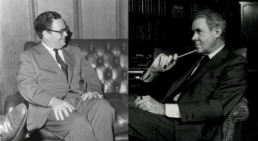
Secretary Vance then promptly made plans to notify Krois’ father in California. Unfamiliar with the TPLF bandits at this time, he sent a cable back to Ambassador Chapin inquiring: if they “could. make a point that any publicity TPLF garners from the kidnapping would be bad? Or would TPLF care as long as they got publicity?”
Ambassador Chapin received the cable and looped in the Canadians which had a stake in Krois’ release since Krois was a Canadian resident with a wife in Toronto.
Both determined to coordinate plans and “to hold the story as tightly as possible” to starve the TPLF of any publicity.
American Call on a Friend
Lacking a direct point of contact with the TPLF, the American Ambassador in Sudan, Donald Bergus, appealed to the Sudanese Government of Jaafar Nimeiry. Nimeiry, a close US and Egyptian ally, was providing financial support and a headquarters in Khartoum to the TPLF[3].
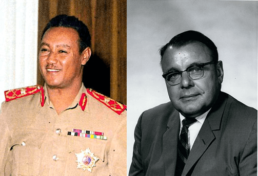
Ambassador Bergus phoned General Omar Al-Tayeb, head of the Sudanese State Security under Nimeiry, and pressed him to approach TPLF representatives in Khartoum to negotiate Krois’ release. After meeting TPLF reps in Khartoum, General Omar reported: “TPLF want money or material assistance of some kind before release of Krois“.
Omar told TPLF of US policy prohibiting ransom of any kind for release of hostages and that any donation would be made “under the table“.
Ambassador Bergus then sent a cable to the State Department to update Secretary of State Vance about the TPLF’s demands as relayed by General Omar. Bergus then waited for next steps from the State Department.
Meanwhile, the Canadians also hatched a plan of their own.
The Canadians Call on a Friend
The Canadian strategy involved reaching out to the British which dealt with TPLF terrorists two years earlier when they ambushed and fired bullets on a Land Rover of a British family, including a 5 and 8 year old, and took the family hostage for 3 months demanding $1M in ransom[2].
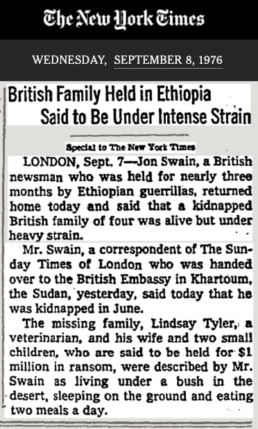
British officials reached out to their TPLF contacts and reported the following:
After meeting in secret with the TPLF rep, the British official notified the Canadians that the rep said unless a ransom was given “Krois would continue to be held to draw attention to the TPLF cause” and that “his group was immune to pressure applied by governments“.
Back in Washington, Secretary Vance emphatically rejected the TPLF ransom demand, and updated his ambassadors in Addis and Khartoum affirming that “there is no question of USG paying ransom and TPLF will only damage its public image by continuing to hold innocents hostage“.
TPLF reps would not budge. They warned a French contact “Krois is well but that he will be kept as long as necessary ‘six months or a year’ to bring western interlocutors to their senses“.
The contact also noted that although a clear ransom demand had not been made yet, “figure being contemplated is thought to be approximately $100,000 or $200,000 in cash“.
TPLF Tries to Indoctrinate Krois’ Wife
Now early one morning, TPLF reps approached a Red Cross official in Khartoum by the name of Fred Isler and demanded that he deliver three letters [4] addressed to Mrs. Beverely Krois (George Krois’ wife in Toronto) to the Canadian embassy to send to Mrs. Krois.
Isler accepted the first two letters which were letters from George to his wife describing his situation, but according to a mid-November cable, “Isler refused to accept a third letter which was a propagandistic explanation from TPLF to Mrs. Krois” justifying Krois’ captivity“.
In the propaganda letter Isler refused, TPLF wrote to Mrs. Krois “the inconvenience of one man for an indefinite period of time” is a worthwhile price to pay for “five million Tigreans”.
They also complained, stating “for the last hundred years the Amhara nation dominated us“.
Though TPLF ultimately pulled back the letters, the gesture presumably was an attempt to demonstrate that they have matured into humane kidnappers. In 1976, a British man kidnapped by the TPLF remarked that he “had to suck water from cactuses to keep going” on a 500 mile march under armed TPLF guards.
Canadians Want UN Involved, Americans Unconvinced
By December, the one month mark of Krois’ abduction had passed. US and Canadian officials were still no closer to securing Krois’ release as when they had started.
The Canadians proposed that the UN Secretary General make a public appeal to the TPLF on humanitarian grounds.

Ambassador Chapin and the Americans were unconvinced arguing “an appeal on humanitarian grounds would, in any case, fall on deaf ears. The TPLF has clearly shown itself to be a politically unsophisticated group, not concerned with the adverse nature of the publicity it might get.”
In Washington, Deputy Secretary of State Warren Christopher had now taken over the Krois’ file. (Christopher would become Secretary of State under Bill Clinton). Christopher was displeased with the Sudanese effort so far and called for more “aggressive” pressure against the Sudanese.
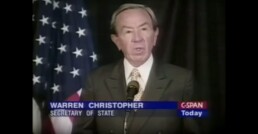
Soon enough, the Sudanese feeling the heat, reassured the US Ambassador in Khartoum that the matter was now personally being handled by Sudanese President Nimeiry and promised renewed pressure would be applied on the TPLF leadership in Khartoum.
Sudanese authorities would then summon TPLF reps in Khartoum. What exactly happened next is unclear. The details of the exchange remain classified. It’s possible the Sudanese threatened the TPLF with expulsion or the Eritreans who had leverage on the TPLF made them fold.
It’s also unclear whether any of the TPLF’s ransom demands were met “under the table” by the Sudanese officials. The Sudanese promised the TPLF a press conference in Khartoum and requested US officials send media reps to the press conference. The US would grudgingly accept.
After more than 2 months of a dizzying diplomatic frenzy and 70 days under TPLF captivity, George Krois’ would finally be a free man on January 9 after the TPLF handed him to Sudanese authorities in Khartoum. A week later he boarded a flight to Toronto and reunited with his wife.

President Nimeiry received a letter of thanks from President Jimmy Carter for his efforts. Carter wrote: “I would like to express my gratitude for your government’s efforts in bringing about the safe release of Mr. George William Krois by the Tigre Peoples Liberation Front“.
Carter Falls, TPLF Terrorism Increases
Only a year later President Jimmy Carter would find himself confronting another hostage crisis, only this time one which he could not keep under wraps and would ultimately take down his Presidency.
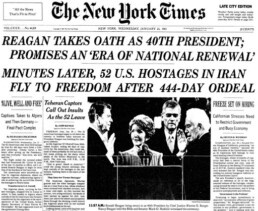
Carter would go down, but TPLF terrorists were just getting started.
TPLF also got its promised press conference with western media and said “they were anxious to call attention of world opinion to plight of Tigrean people who were fighting a fascist government”.
If this language sounds familiar, we don’t need to look further than the recent words coming out of today’s TPLF terrorists who have waged war on the country:
For the George Krois’ kidnapping and more than a dozen other documented acts of international terrorism committed throughout the 70s and 80s, the TPLF found itself listed as a Tier III terrorist organization under United States law.
Yet, despite their rocky beginning, the TPLF and the US would forge a closer relationship in the late 80s. Ethiopia would expell Ambassador Chapin and the Americans in July 1980 and the US wouldn’t regain a foothold in the country until facilitating a TPLF takeover in 1991.
Today, once again, true to its terrorist roots, the TPLF, with American approval, is terrorizing the people of Tigray, Amhara, and Afar regions and holding them hostage while demanding a ransom of more than 100 million Ethiopians.
Notes
1.The US had been aware of efforts to create a “Tigray Liberation Front” at least since April 1975, which is two months after TPLF’s official founding.
2. British Surgeon Lindsey Taylor was on vacation with his wife and his 8 and 5 year old children when TPLF gunmen ambushed his vehicle and kidnapped the family. This story on the Sunday Times recounts this event and also an addition TPLF kidnapping.
3. Incidentally, just like today, in 1977-78 while Ethiopia was preoccupied with war with Somalia, Nimeiry’s troops invaded fertile lands of Ethiopian farmers in Gonder and in later years, according to a statement by the Ethiopian Border Affairs Committee, TPLF leaders promised Neimery that they would abrogate the 1902 Border Treaty if they took power in Ethiopia.
4. Here’s the full content of the TPLF propaganda letter sent to Mrs. Krois.
Share
Ethiopian Geopolitics: An Enigma of International Norms
Blog
Bethlehem Mehari
International Economics and
Conflict Management
Twitter : @Beth_Mehari
Ethiopia’s reformed leaders, under the headship of Prime Minister Abiy Ahmed, are grappling with the harsh reality of ethnic politics, that is nearly three decades in the making, and a diplomatic stand-still with the Nile’s downstream riparian over its flagship project, the Grand Ethiopian Renaissance Dam (GERD). In an effort to mitigate the Coronavirus pandemic, Ethiopia postponed its 6th General elections from August of 2020 to early June of 2021 and has made significant logistical and security preparations. In rejection of the new timeline, the Tigrean People’s Liberation Front (TPLF), members of the ancéan regime, opted to institute a novel regional election board and subsequently held elections on September 9th of 2020. Labeling the TPLF leadership as rogue militants, the Federal Government was forced into a law and order operation in the Tigray region which has come at a high human cost, infrastructure damage, as well as looting which has left the region in a fragile state of severe food-insecurity. In addition, armed ethnic extremists in parts of Oromia and Benishangul-Gumuz regions continue to harass, expel, as well as kill minority populations which adds to public discontent, further heightening the risk for electoral violence.
In April of 2019, many were quick to praise Ethiopia’s political reform and normalization of relations with the neighboring state of Eritrea, deeming it the conflict-resolution success story of modern history. The Nobel Committee also acknowledged the Prime Minister’s role in expanding political rights and participation through rigorous legislative and institutional reforms. In hindsight, it has become abundantly clear that the cycle of political violence that historically accompanied political transitions in Ethiopia was not avoided, rather, it was delayed. Shortly after the TPLF attack on multiple bases of the Ethiopian National Defense Forces (ENDF) in Tigray- the Prime Minister revealed that, in the backdrop of his Nobel accolade, his safety and that of his family was under threat by the TPLF controlled security apparatus. The start of open hostilities in November of 2020 marked the official end of multiple attempts at mediation. According to a TPLF spokesperson, Sekko Ture, the TPLF indeed declared a preemptive attack on Ethiopia’s Northern Command, likening the assault on sleeping service members to a lightning strike.
Seeing that the Ethiopian Army has left its post due to the abrupt start of hostilities in Tigray, Sudanese forces moved to occupy large swaths of land in the disputed al-Fashaga territory. Sudan’s move not only violates Ethiopia’s territorial integrity but also risks derailing decades of work to arrive at a peaceful resolution through existing regional mechanisms. Though Ethiopia was quick to denounce the move as an opportunistic land-grab, Sudan barely received the proverbial slap on the wrist from the European Union, the United States, and the United Nations organs. As Ethiopia juggles between these domestic and regional challenges, international and non-government organizations, along with friends and allies of Ethiopia were quick to offer prescriptive measures to both the potential insurgency in Tigray as well as GERD negotiations. However, the response of the United States, the European Union, international media houses (both private and state-affiliated), have largely been reactionary and inconsistent with customary international law. The principle of sovereign equality of nations detailed in the Article 2 of the United Nations Charter, a cornerstone for the conduct of nations vis-à-vis international organs, all member states,“… shall refrain in their international relations from the threat or use of force against the territorial integrity or political independence of any state, or in any other manner inconsistent with the Purposes of the United Nations.[1]” Sudan has instead doubled down on its military actions with identitarian claims of the resident population of the disputed area. Despite multiple protestations by Ethiopian officials, the deafening silence from the international community has emboldened Sudan to make further claims on swaths of Benishangul-Gumuz where the Grand Ethiopian Renaissance Dam is, rather conveniently, located.
With the recent memory of Myanmar’s hostile military takedown of the civilian government, it is highly unusual that the United States and the European Union would opt to liaise with Sudan’s military leadership, particularly during a rapidly escalating border dispute with Ethiopia. Although the United States asserts its commitment to working with the civilian-led government, the increased isolation of Prime Minister Hamdok in domestic and regional affairs indicates the contrary. Having had its own attempted insurrection in January, the United States has persistently called on the Ethiopian Government to negotiate with its own insurrectionists so as to avert further casualties. In an interview with Foreign Policy, the new US envoy to the Horn of Africa Jeffery Feltman expressed concern that Ethiopia may be headed toward a path of disintegration, likening Ethiopia’s current trajectory to that of Syria. Setting aside the envoy’s outlook of Ethiopian affairs through a Middle East lens, the concerted effort at normalizing and rehabilitating the TPLF’s public image has angered Ethiopian officials as well as the larger public. In addition to Mr. Feltman who eulogized the late Prime Minister Meles Zenawi, a core member of TPLF’s central committee, current and former officials like Susan Rice, Michelle Bachelet, Karen Bass continue to exploit existing ethnic cleavages and muddying the waters by perpetuating a narrative of an ethnically-motivated government-response; some even demanding the withdrawal of regional forces fighting alongside the ENDF.
Many in the international community have adopted a unitary strategy of pressuring the Ethiopian government to act against its national interest in both the trilateral GERD talks and the turmoil in Tigray. Prominent global players, international media and humanitarian agencies included have largely been fanning the flames of ethic-contention, and clear favoritism in horn affairs, making evident that international norms have increasingly become subject to interpretation and selective application. After multiple rounds of failed negotiations, and President Trump’s withholding of aid and threats that “Egypt will have to bomb the dam,” it is evident that Ethiopia’s downstream counterparts were in search of formidable intermediaries who can coerce Ethiopia into a binding agreement, making all future projects on the Abbay River contingent on Egypt’s blessing. This begs the question: is the goal of these talks to subdue Ethiopia’s real developmental concerns in favor of the status-quo? Egypt’s unrelenting threat of “unimaginable chaos” to the horn and Sudan’s continued encroachment into disputed territories undercuts the international community’s continued call for a diplomatic solution; in reality, defiance is rewarded with silence, or worse- distortion. It is crucial that Ethiopia be considered an equal and autonomous stakeholder with its regional partners, and although the Horn’s latest envoy does not believe the GERD dispute to be “inherently irreconcilable,” this sentiment alone does little to restore hope that the United States can be an honest broker.
Studies have shown water to be a key factor in 45 current conflicts and is predicted to be a major cause of conflict and displacement in the foreseeable future. With the worsening trend of global water security, a thorough consideration for the concerns and vulnerabilities of all parties is crucial in reaching a collaborative and mutually beneficial outcome. It is for this reason that all parties need not approach the issue as a play of great powers at tipping the scale. The European Union, United Nations organs, as well as the United States must endeavor to encourage the current African Union led process so as to expand the proverbial pie, instead of bickering over the crumbs.
Share
The Elephant in The Room: What is behind the stalled GERD Negotiation and how should it move forward?
Blog
Dr. Tirusew Asefa
Dr. Tirusew Asefa is a registered professional engineer with the State of Florida, a Diplomate of the American Academy of Water Resources Engineers, and a Fellow of the American Society of Civil Engineers. He currently chairs Florida Water and Climate Alliance.
Email : mululove@yahoo.com

Every roadblock in the tripartite negotiation between Egypt, Ethiopia, and the Sudan leads to one issue: Nile water use allocation. Both Egypt and Sudan are adamant on showing even a hint of flexibility, sticking to their proposition in the 1959 colonial agreement between the two countries that granted them 100% utilization of the Nile water. Dr. Salman M.A. Salman, an expert in water and law and Editor-in-Chief of Brill Research Perspectives in International Water Law, sees the problem with this agreement starting from its title which says “…full utilization of the Nile.” This is at the expense of the rest of the Nile basin countries who are responsible for the “full” supply of the Nile water. Even more so at the expense of Ethiopia who generates 86% of the total Nile flow. Ethiopia finds its zero percent water allocation as a nonstarter no matter how it is packaged: whether it is called “benefit sharing,” “extended drought release” “existing water use,” or “an existential threat caused by any reduction.”
A recent weASPiRE webinar that I hosted among four international experts on water, economic, law, and policy raised this very problem as a core issue for stalled negotiating between the three countries.
As it stands, both Egypt and Sudan are insisting on a “binding agreement” before Ethiopia starts the second year of the Grand Ethiopian Renaissance Dam (GERD) filling at 13.5 BCM this summer. This filling is part of the GERD construction that was agreed upon by the three countries making it almost impossible not to hold water because of its link with construction of the central block of the dam. Once the central block of the dam is raised, more water will be coming into the GERD during the summer rain that can not get “unheld.” The issue is not whether there is enough water in the basin this summer (given that the High Aswan Dam’s current level is still at 20-year high and river flow is projected to be at an above average flow condition); it is rather how the operation of the GERD would look like in the future. The ultimate goal seems to be to impose a “binding” zero allocation to Ethiopia.
Should the GERD filling agreement be decoupled from long-term operation?
There are many independent experts including the European Union that found it problematic to push for a “binding agreement” for the GERD’s operation as Egypt and Sudan are insisting without addressing the underlying water allocation issue. For example, the EU while supporting the African Union’s (AU’s) leadership notes the first filling can be addressed to everyone’s satisfaction and adds “the operations after the filling need further discussions to reach a water sharing arrangements, as occurs in all river basins.”
This is the same sticky situation that resulted in a no-solution agreement by the so-called US-World Bank mediation back in the fall of 2019. In that draft document, Egypt asked for a “binding” release scenario that effectively cuts the GERD’s ability to produce power by one-third and greatly diminishes the chances of filling the dam. Dr. Salman sees this as the single most critical issue that has been in discussion between the three countries for more than a decade with no breakthrough yet. He says, “you can do the filling and operation [discussion]… and at the same time… raise the issue of water allocation.” Dr. Marc Jeuland, a professor at Sanford School of Public Policy, sees the water sharing issue as a prerequisite to get to a permanent binding water release agreement during the GERD operation. Without acknowledging and figuring that out, it will be difficult to get to a place that is acceptable by all parties. The water sharing issue of who gets how much is a key way to get out of this stalled negotiation. Dr. Jeuland asks whether you need the water rights to be cleared to devise a long-term operation strategy. He thinks you do. “There needs to be some discussions about what those rights are,” he stated.
Who is responsible for drought management?
One of the contended points in the negotiations between Egypt and Ethiopia is the priority of dam filling between the High Aswan Dam (HAD) and the GERD after an extended drought. Egypt insists Ethiopia should release a certain amount of flow beyond what Ethiopia has already committed, which is the flow that would have occurred without the GERD, plus additional storage. Egypt insists these releases should be in place regardless of changes in future hydrologic conditions (including potential flow changes because of climate change or upstream water use) effectively putting the task of water supply during periods of drought and its management solely on Ethiopia. Ethiopia says it is not responsible for all the problems that could be created by mother nature. A complicating factor is the lack of a water sharing agreement that could be executed during this kind of scenario which would enable Ethiopia to use its share to fill its dam in a future scenario.
Dr. Upmanu Lall, who is the director of Columbia Water Center at Columbia University, says that is exactly the issue, “in the absence of a sharing agreement, how do you actually bring these [countries] to the table? You can spend years negotiating an agreement and the terms of that agreement would have to include every contingency with regards to different kinds of drought. That’s a nonstarter in a way.” Many observers point to the lack of Egypt’s willingness to the use of alternative water sources during drought time as well. During such extreme cases, for example, Egypt could tap into its vast groundwater sources or diversify its resources by tapping into desalinated water which over the years has come to be much cheaper than what it was just a decade ago. Framing the solution for all water shortage in Egypt to surface water coming from Ethiopian highlands misses what water resources managers could do to manage extremes droughts, specifically conjunctive water use. “It is not like as soon as there is less water, there is no option anymore. There are options. Maybe tapping groundwater that you don’t typically use could be the solution during this extreme drought,” says Dr. Jeuland.
There is also a creative solution in terms of insurance instruments that could come into play to tackle unforeseen extreme drought situations according to Dr. Lall. Our experience shows the so-called VarQ operating regime in the Columbia River agreement between the US and Canada can be used as an example where additional drought-time release deemed necessary and may not be part of the initial agreement can be accommodated. In such instances the dam owner could be compensated to operate in a way that can help downstream countries overcome unexpected circumstances. Questions that can be considered are: “If you think that [drought] is a shared risk, in terms of securitization strategy how much money would you like to receive if the flow drops below a certain level and how much are you willing to pay for it?” This approach could be one way to manage extreme droughts that have a small chance of occurring but can have serious consequences. “Both Egypt and Ethiopia can then independently decide for themselves and negotiate the terms of the insurance” adds Lall. But a successful application of such an approach would depend, again, on prior water sharing agreement among Nile basin countries, which is non-existent today.
Do Egypt, Ethiopia and Sudan need more mediators to get to a solution?
Recently Sudan proposed to add more mediators to the tripartite negotiation. This includes the United Nations, European Union, and the USA, in addition to the African Union which currently leads the effort. It is to be noted that the last time a third party tried to mediate between these countries (US/World Bank), they ended up writing what many call a one-sided draft document that was thought to be heavily tilted towards Egypt. The former US Ambassador to Ethiopia, Mr. David H. Shinn said at the time “the United States seems to be putting its thumb on the scale in favor of Egypt.” Ethiopia walked out of that negotiation. There are many who say the role of a third-party facilitator is to provide ideas, data, new ways of framing the issue, and knowledge from similar experiences outside the present matter that enable the parties to sustain engagement and eventually reach an agreement. Other than that, the parties must come to agreement by themselves. That is the only way toward sustained solution. Prof. van der Zaag, of IHE Delft in the Netherlands, cautioned against approaches that involve outsiders which may result in direct conflict to the stakeholders’ benefits, lack a local perspective, and may even be against the parties’ interest. Under such a scenario, he says, “donors become part [of the problem] and add more complexity. You cannot, as an outsider, make parties agree.” This is a similar sentiment reflected by Dr. Salman, stressing “the presence of more than one mediator could end up being a complicating factor [rather] than facilitating one.”
Where do we go from here?
One thing that is clear from my panelists is there is a way forward that could potentially be a win-win solution. But some parties may need “out of the box” thinking and have a willingness to see the big picture with regards to what works for all countries in the region. “The most important thing is to focus on what a joint vision of the future looks like, a positive vision that you would like to achieve across these countries and [figuring out] how the water story fits into that rather than driving from how do we negotiate the water” first, says Dr. Lall. Concentrating on what each country gains rather than what it perceives to be losing is another way to look at it according to Salman. He says “They need to try to find out first what can Egypt get out of this dam, what can Sudan get out of this dam. Concentrate on that. Build on that. Strengthen that and it will be a major step in helping the mediating effort.”
The key to achieving collaboration among these countries, according to Jeuland, is “depoliticization” of the whole process to get to a cooperative framework. He also sees that concentrating on institutions and trust to generate this mutual benefit are more important than cubic meters of water. There is ample evidence from around the world where this resulted in positive outcomes rather than conflicts. Dr. van der Zaag advises this discussion needs to take out the emotion including reporting by journalists who tend to sensationalize things as no one chooses their neighbors. These countries will be living together and need to think about the next generation to get the best out of the resources they have.
The message is that there is more to gain by all three countries through cooperation than concentrating on a single country’s benefit.
A starter will be acknowledging the share and the right of utilization of the Nile water by both upper and lower riparian basin countries. Every challenge to the negotiation between the tripartite states so far leads to one problem: water allocation. While the Egyptians say it is not about water allocation and just about the GERD, the elephant in the room is a water allocation issue that needs to be addressed to get to a permanent “binding” agreement which everyone will be happy to accept.




